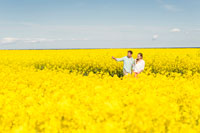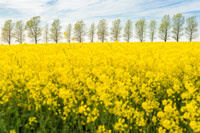2015 Rapeseed Flowering Press Photos
A plant with culture
 Spring without fields of rapeseed flowers? Hard to imagine. In Germany, the brilliant yellow of these fields is akin to what cherry blossom is for the Japanese. There are rapeseed festivals and beauty queens to celebrate the event. Today these yellow rapeseed fields are an established fixture of our cultural landscape. One thing rapeseed is not, is a monoculture. Even if there are a lot of fields, and in some areas of Germany these may be quite large, rapeseed is never grown in the same field in successive years. It is not possible to cultivate rapeseed as a monoculture because it is self-incompatible. This means it requires an interval of at least three years for a typical rotation of crops of rapeseed, wheat and winter barley. Think about that. (Photo: UFOP)
Spring without fields of rapeseed flowers? Hard to imagine. In Germany, the brilliant yellow of these fields is akin to what cherry blossom is for the Japanese. There are rapeseed festivals and beauty queens to celebrate the event. Today these yellow rapeseed fields are an established fixture of our cultural landscape. One thing rapeseed is not, is a monoculture. Even if there are a lot of fields, and in some areas of Germany these may be quite large, rapeseed is never grown in the same field in successive years. It is not possible to cultivate rapeseed as a monoculture because it is self-incompatible. This means it requires an interval of at least three years for a typical rotation of crops of rapeseed, wheat and winter barley. Think about that. (Photo: UFOP)
Download Press Photo (.jpeg, 300 dpi)
Hunger for rapeseed protein
 Rapeseed has started to flower across the country. With just over 1.3 million hectares sown last August, farmers have sown a little less seed for our most important native oil and protein-producing crop. Even if it is the demand for rapeseed’s high-quality oil that has turned it into a real success story over the past 20 years, today it is the hunger, in the truest sense of the word, for rapeseed protein that is driving demand. When the rapeseed is pressed, not only oil but also an even greater quantity of rapeseed cake or rapeseed meal is produced. It provides the most important home-grown, GM-free protein component in feed for cows, pigs and poultry. This reduces the need for both imported and predominantly GM soybean meal. (Photo: UFOP)
Rapeseed has started to flower across the country. With just over 1.3 million hectares sown last August, farmers have sown a little less seed for our most important native oil and protein-producing crop. Even if it is the demand for rapeseed’s high-quality oil that has turned it into a real success story over the past 20 years, today it is the hunger, in the truest sense of the word, for rapeseed protein that is driving demand. When the rapeseed is pressed, not only oil but also an even greater quantity of rapeseed cake or rapeseed meal is produced. It provides the most important home-grown, GM-free protein component in feed for cows, pigs and poultry. This reduces the need for both imported and predominantly GM soybean meal. (Photo: UFOP)
Download Press Photo (.jpeg, 300 dpi)
Certificated sustainable mobility
 There are currently more than 1.3 million hectares of rapeseed fields flowering in Germany. No wonder we feel spring is in the air. Any of you driving a diesel vehicle round at the moment don’t just have rapeseed fields right in front of your eyes, your tank has up to 7 per cent rapeseed too. That doesn’t just save mineral oil, but large quantities of CO2 as well, as today the production and use of biofuels already produces 60 per cent less greenhouse gases than fossil fuels do on average. In future the savings should be even greater. To ensure that this is definitely not at the cost of nature, environmental organisations and legislators have put great emphasis on the sustainable production of raw materials to produce biofuels. This is certainly the case for rapeseed from Germany as the German harvest is certified as sustainable. To achieve this, the rapeseed must pass a comprehensive checklist covering everything from cultivation to processing. To date this globally applicable standard for sustainability has only been regulated by law for raw materials used for biofuels. (Photo: UFOP)
There are currently more than 1.3 million hectares of rapeseed fields flowering in Germany. No wonder we feel spring is in the air. Any of you driving a diesel vehicle round at the moment don’t just have rapeseed fields right in front of your eyes, your tank has up to 7 per cent rapeseed too. That doesn’t just save mineral oil, but large quantities of CO2 as well, as today the production and use of biofuels already produces 60 per cent less greenhouse gases than fossil fuels do on average. In future the savings should be even greater. To ensure that this is definitely not at the cost of nature, environmental organisations and legislators have put great emphasis on the sustainable production of raw materials to produce biofuels. This is certainly the case for rapeseed from Germany as the German harvest is certified as sustainable. To achieve this, the rapeseed must pass a comprehensive checklist covering everything from cultivation to processing. To date this globally applicable standard for sustainability has only been regulated by law for raw materials used for biofuels. (Photo: UFOP)
Download Press Photo (.jpeg, 300 dpi)
This is where Germany’s favourite oil grows
Rapeseed oil is Germany’s number one cooking oil. No other cooking oil finds its way into shopping baskets as often as rapeseed oil does. And the brilliant yellow of our rapeseed fields bears impressive witness to the fact that there are sufficient supplies for the future. The figures for this are also impressive. Rapeseed is currently flowering across more than 1.3 million hectares. This is approx. eleven per cent of Germany’s arable land. In a few weeks, farmers will harvest more than five million tonnes of rapeseed from this. If this quantity were transported in a goods train, it would be a remarkable 1,800 km long. (Photo: UFOP/Sven Geist)
Download Press Photo (.jpeg, 300 dpi)
Protector of the rain forest
Every spring flowering rapeseed is a spectacular sight across the country. A large proportion of the oil extracted from the rapeseed after the harvest finds its way into the fuel tanks of vehicles, where it is blended together with fossil diesel as biodiesel. Theoretically this can power three million cars for a year without a drop of crude oil. But it is not just imports of fossil fuels that are reduced by this. Imports of soybean meal are also reduced by around 2.6 million tonnes, because the production of rapeseed fuel automatically produces this amount of animal feed. This replaces soya imports equivalent to approximately one million hectares. In this way, the cultivation of rapeseed in Germany contributes to the protection of the rain forests in South America, which have all too often yielded to the world’s hunger for soybean meal. (Photo: UFOP/Sergej Tarabrin)


 Union zur Förderung von Oel- und Proteinpflanzen E.V.
Union zur Förderung von Oel- und Proteinpflanzen E.V.